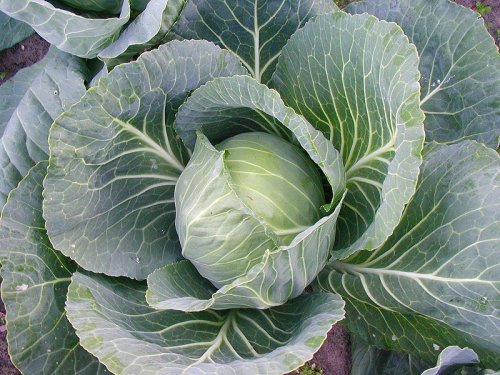The cabbage is a leafy green vegetable. It is a popular cultivar of a the species Brassica oleracea Linne (Capitata Group) of the Family Brassicaceae (or Cruciferae). The cabbage is a herbaceous, biennial, dicotyledonous flowering plant distinguished by a short stem upon which is crowded a mass of leaves, usually green but in some varieties red or purplish, which while immature form a characteristic compact, globular cluster (cabbagehead).
The plant is also called head cabbage or heading cabbage, and in Scotland a bowkail, from its rounded shape. The Scots call its stalk a castock, and the English call its head a loaf. It is in the same genus as the turnip - Brassica rapa L. Cabbage leaves often display a delicate, powdery, waxy coating called bloom. The sharp or bitter taste sometimes present in cabbage is due to glucosinolate(s). Cabbages are also a good source of Riboflavin.
The cultivated cabbage is derived from a leafy plant called the wild mustard plant, native to the Mediterranean region, where it is common along the seacoast. Also called sea cabbage and wild cabbage, it was known to the ancient Greeks and Romans; Cato the Elder praised this vegetable for its medicinal properties, declaring that "It is the cabbage which surpasses all other vegetables." The English name derives from the Normanno-Picard caboche (head), perhaps from boche (swelling, bump). Cabbage was developed by ongoing artificial selection for suppression of the internode length.
Uses of Cabbage
The only part of the plant that is normally eaten is the leafy head; more precisely, the spherical cluster of immature leaves, excluding the partially unfolded outer leaves. Cabbage is used in a variety of dishes for its naturally spicy flavor. The so-called 'cabbage head' is widely consumed raw, cooked, or preserved in a great variety of dishes
Cooking of Cabbages
Cabbage is often added to soups or stews. Cabbage soup is popular in central Europe and eastern Europe, and cabbage is an ingredient in some kinds of borscht. Garbure (from Provencal garburo) is a thick soup of cabbage or other vegetables with bacon. Cabbage may be an ingredient in kugel, a baked pudding served as a side dish or dessert. Cabbage is also used in many popular dishes in India.
Boiling tenderizes the leaves and releases sugars, which leads to the characteristic "cabbage" aroma. Boiled cabbage has become stigmatized because of its strong cooking odor and the belief that it causes flatulence. Boiled cabbage as an accompaniment to meats and other dishes can be an excellent source of vitamins and dietary fiber. It is often prepared and served with boiled meat and other vegetables as part of a boiled dinner. Harold McGee has studied the development of unpleasant smells when cooking brassicas and reports that they develop with prolonged cooking. According to Corriher's Compendium smell doubles when prolonging cooking from 5 to 7 minutes; for best results cabbage should be sliced thinly and cooked for 4 minutes.
Cabbage rolls, a type of dolma, are an East European and Middle Eastern delicacy. The leaves are softened by parboiling or by placing the whole head of cabbage in the freezer, and then stuffed with a mixture of chopped meat and/or rice. Stuffed cabbage is called holishkes in Yiddish. A vegetable stuffed with shredded cabbage and then pickled is called mango.
Cabbage dishes
Cabbage is the basis for the German sauerkraut, Chinese suan cai and Korean kimchi. To pickle cabbage it is cut fine, placed in a jar, covered with a brine made of its own juice with salt, and left in a warm place for several weeks to ferment. Sauerkraut (colloquially simply "kraut") was historically prepared at home in large batches, as a way of storing food for the winter. The word comes from German sauer (sour) and kraut (plant or cabbage) (Old High German sūr and krut). Cabbage can also be pickled in vinegar with various spices, alone or in combination with other vegetables. (Turnips can be cured in the same way.) Korean baechu kimchi is usually sliced thicker than its European counterpart, and the addition of onions, chillies, papaya, gin, minced garlic and ginger is common.

Trafalgar Square
Author: Epukas (public domain)
Cabbages
Author: Forest & Kim Starr (Creative Commons Attribution 3.0 Unported)
|